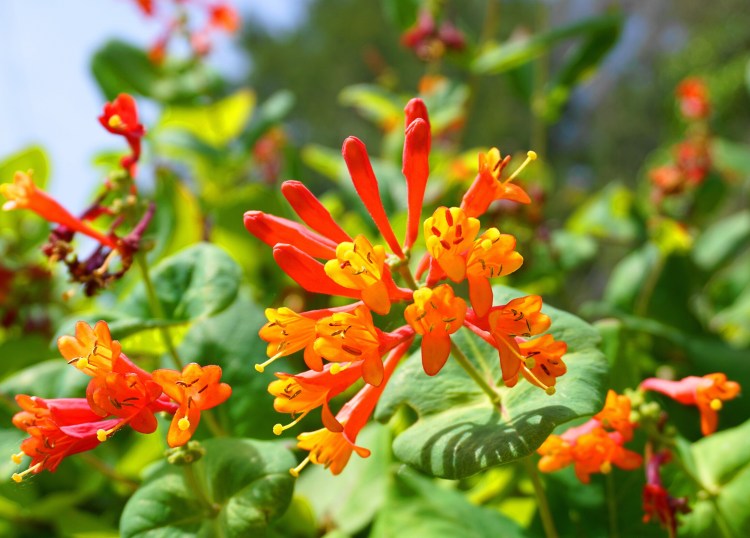National Pollinator Week ended last weekend, so I’m a little late with this. But I’m going to forgive myself, and you should, too. I’ve been unbelievably busy this June (I won’t bore you with the details) and discovered the national event later than I should have.
But my missing the event until it was over doesn’t affect the information. It has been so cool for us this year and we are so far north that the information event organizers give for more southerly climes is right for us just about now. It is possible, and easy, to put in pollinator-friendly plants now that will provide benefits this year and, for many of the plants, a long time to come.
First, what are pollinators? The first ones most people think of are honeybees, which have been in trouble for more than a decade, jeopardized by colony-collapse disorder and other problems. But honeybees – which are not native to the Americas and are farmed commercially – are not the only, or even the most important, pollinators.
“Approximately 75 percent of both food crops and flowering plants rely on ants, bees, butterflies, bats and other animals,” Debbi Edelstein, executive director of the Native Plant Trust (formerly the New England Wild Flower Society), said in a statement urging people to take action to preserve and protect pollinators. And the honeybees are not the prime pollinators in the wild.
According to the University of Maine Cooperative Extension, Maine has 270 species of native bees.
“Bees are ‘keystone organisms’ in most terrestrial ecosystems,” according to Bulletin No. 7153, prepared by Constance S. Stubbs and Nancy Coverstone. “Bees are essential for maintaining the integrity, productivity and sustainability of many types of ecosystems: the forest understory, pastures, fields, meadows, roadsides, many agricultural crops, fruit orchards, and backyard vegetable and flower gardens. Without bees, many flowering plants would eventually become extinct.”
So, we know why pollinators are important – but why are they in trouble? It’s a combination of factors.
The plant choices people make are partly to blame. From the bee’s perspective, the typical American lawn is sterile. Bees need flowering plants that produce pollen and nectar. And while native flowers are best, because they developed alongside the native pollinators and make nutritious food for them, non-native flowers also provide some benefits. When you see bees buzzing around white clover and dandelions, which are not native, you know the plants are providing some benefit.
Indiscriminate use of pesticides is another problem. While insecticides will kill the insects that are damaging your flowers, even the organic insecticides will also kill bees. Never spray pesticides on a plant when it is in bloom and bees are likely to be on it.
The varroa mite, which is a big problems for honeybees, also harms Maine’s native bees.
And as with everything else, it seems, climate change is causing problems for pollinators.
That’s the bad news. There is not much a home gardener can do to bring an immediate halt to climate change, although every little bit helps in the long run, nor is there a home solution to the varroa mite and other diseases.
But everyone can use pesticides responsibly – or not at all.
Now let me turn to the fun part: adding pollinator-friendly plants to your garden.
The Native Plant Trust offers a group of eight plants that it calls its “Pollinators’ Feast.” They are:
Aclepias tuberosa, or butterfly milkweed
Amelanchier canadensis, or serviceberry
Aquilegia canadensis, or Columbine
Eutrochium maculatum, or Joe Pye weed
Helianthus divaricatus, or woodland sunflower
Liatris novae angliae, or Northern blazing star
Lonicera sempervirens, or trumpet honeysuckle
and Monarda fistulosa, or wild bergamot.
That’s a good list, and you can buy many of them as plants at local nurseries or as seed from the Wild Seed Project. But though they all are attractive plants that are easy to grow, don’t limit yourself to that list.
The Extension bulletin suggests purple, blue and yellow flowers planted in mass, and suggests using flowers of different shapes – because different bees can access pollen and nectar in different flowers more easily. Double flowers are often sterile, so should be avoided.
It is important that some pollinator-friendly plants be available throughout the gardening season, so the Extension, in its bulletin, lists plants that are in blossom from early spring to late October. The list includes non-native bulbs such as crocus, daffodil and tulips; trees such as red maple, red oak, plum, cherry and apple; herbs such as thyme, chives, oregano and borage; shrubs such as serviceberry and blueberry; perennials such as viola, coneflower, lamb’s ear and asters and annuals such as anise hyssop.
In addition to being beneficial, they also are attractive.
You don’t even have to put the plants in the ground; containers will also work. Annuals such as cosmos, marigolds, bachelor’s buttons and sunflowers are attractive and helpful to bees.
So, add some beauty to your garden and help the pollinators – it may be too late for National Pollinator Week, but it’s not too late for the bees.
TOM ATWELL is a freelance writer gardening in Cape Elizabeth. He can be contacted at: tomatwell@me.com
Send questions/comments to the editors.


